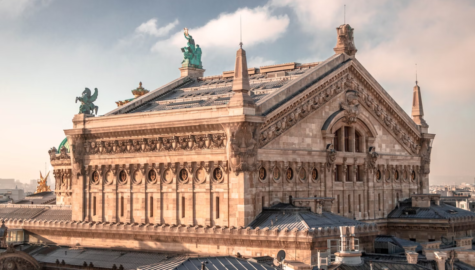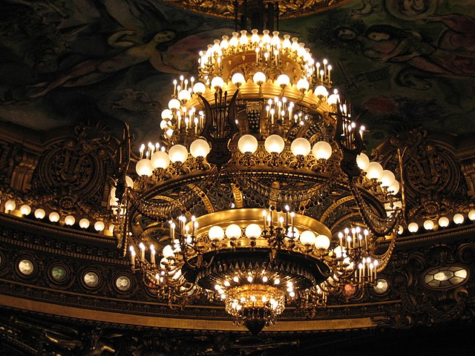The Phantom’s Final Performance: A Look at Broadway’s ‘Phantom of the Opera’ Production
A recap of Broadway’s ‘The Phantom of the Opera’ and a look into why the production is so iconic.
Epicgenius, CC BY-SA 4.0
Broadway’s ‘Phantom of the Opera’ has been performed at the Majestic Theater since 1988.
Elaborately designed costumes, carefully constructed lighting, riveting music, and intricate set designs — these are only some of the components that make up a musical. The goal is that each of these parts will work harmoniously with the rest of the production while being extraordinary in itself.
The Phantom of the Opera, a musical created by Andrew Loyd Webber, succeeds in this goal. First performed in the heart of London at Her Majesty’s Theater, the musical has left its impact on 33 countries and 183 cities.
The Phantom of the Opera is Broadway’s longest running show, lasting an astonishing 35 years, which ultimately came to an end this year. It was originally announced that the show would close on February 18th, 2023. Cameron Mackintosh, the producer of The Phantom of the Opera, cited a combination of high production costs and decline in tourism as the reasons behind the closing. Following the announcement, there was a rapid increase in ticket sales. Subsequently, the closing date was extended to April 16th, 2023.
To simply say that Broadway’s The Phantom of the Opera was popular would be a vast understatement. The musical has accumulated more than 19 million viewers over almost 14,000 performances. Furthermore, the production has won numerous awards, including seven Tony Awards, seven Drama Desk Awards, and five Outer Critics Circle Awards.
Of course, some of the musical’s immense acclaim can be attributed to the prevalence of the original novel by Gaston Leroux and previous The Phantom of the Opera adaptations. But the way that musical specific features are blended with the previously established story is the true reason behind its current status.
The Phantom of the Opera follows a chorus girl named Christine who performs incredibly while filling in for the lead soprano Carlotta. Her performance unravels the mysteries surrounding the obscure Erik, otherwise known as The Phantom. The entire story takes place in an opera house-making Erik The Phantom of the Opera.
Masterfully crafted music assists in capturing the feeling of being in an actual opera house. Throughout the musical Christine performs in three operas, Hannibal, Il Muto, and Don Juan Triumphant. Since these in-story operas are inspired by real life operas, they contain many operatic elements.
“The mood of the music (the key that it’s in) helps to describe a character’s emotions in a way that may be more complex than can be simply acted out,” said Zoe Levitt ’25, Sound Director of Bronx Science’s Atomic Theater Company. From the jaw-dropping reveal of the Phantom’s true face to the slow romantic build up between Christine and Raoul de Chagn, her childhood best friend, emotions are a major component of The Phantom of The Opera. The Phantom of the Opera’s music is crucial in heightening these emotional moments.

The songs “The Music of the Night” and “The Point of No Return” express the degrading impact of society’s treatment towards The Phantom due to his physical appearance. The Phantom’s treatment is essential to his character, being the driving force behind his initial actions.
Similarly, the songs “Wandering Child/Bravo, Monsieur” and “Beyond the Lake” demonstrate what makes Christine so important – her compassion. Her conflicting emotions when it comes to The Phantom and Raoul de Chagn are highlighted in these songs. Even though the average person would immediately abandon the deformed and creepy man, Christine comes back. The compassion Christine harbors for the Phantom contrasts with the cruelty that the rest of society shows to him.
Leroux was inspired by the Palais Garnier, an opera house in France, and he adapted many of its features into his novel. The massive lake in the Phantom’s lair is eerily similar to the lake under Palais Garnier and the chandelier falling is based on the Palais Garnier’s chandelier’s counterweight falling during a performance of Helle.

The chandelier crash reveals to the audience just how dangerous the Phantom truly is. He is in control of the opera house and is not afraid to use this control to wreck chaos if he does not get what he wants.
Ignoring its significance in the story, the chandelier itself is a sight to behold. It’s the production’s crown jewel, being adorned with 6,000 crystal beads and weighing 1,500 pounds. At the beginning of the show, it glides up to the top of the theater in an ominous manner. Later, near the end of Act I, it comes crashing down. If an ordinary viewer watches the musical without knowing about the drop beforehand, they can be truly frightened.
The chandelier is not the only outstanding prop from The Phantom of the Opera. Maree Johnson, the last actress for the ballet mistress Madame Giry, said that the letters from the Phantom were her favorite prop because “the notes are a very powerful form of information that she [Madame Giry] controls.” Whether it be a simple note or a gigantic chandelier, each prop is carefully curated to further the story.
Costumes offer a similar contribution. The costumes for The Phantom of the Opera were designed by Maria Björnson, whose work won her two Tony awards: Best Scenic Design and Best Costume Design. There are over 230 costumes, spanning from the masquerade scene’s colorful ball gowns to the Phantom’s simple tailsuit. In all of them color takes a prevalent role.
“Over time, many people have associated colors to different emotions and personality, which can add more depth behind the character,” said Benzir Raida ’23, Costumes Co-Director at Bronx Science’s Atomic Theater Company. This is especially apparent in The Phantom of the Opera, from Madame Giry’s all black ensemble emphasizing her authority to the elaborate silver design on Carlotta’s black dress displaying her wealth and fame.
The costumes’ colors are also used to differentiate between the earlier mentioned operas. “Colors are also used to present social status and culture they are living in,” said Raida. The opera’s various settings are highlighted by their color scheme. Hannibal, depicting the Carthaginian army during the Punic Wars, has a bold red, green, and gold color scheme while Il Muto, taking place in 18th century Spain, has a pastel pink, white, and light green color scheme.
Color is not the only component that needs to be considered when designing costumes. “You need good style (like layering, jewels, a certain look or inspiration from different clothing) to accompany the colors,” said Raida. Hannibal’s bejeweled costumes set a completely different tone than Il Muto’s regal gowns.
These costumes, along with every other part of The Phantom of the Opera’s set, make the final farewells difficult. However, if you missed seeing it, don’t fret.
“It’s now being produced around the world with different creative lenses,” said Johnson. “There are different directors, musical directors, and designers that are now creating this piece.” They may not be a replica of the Broadway performance, but each version stands out in their own way. Last year, Johnson was in an outdoor Phantom of the Opera production on Sydney Harbour. “It’s the same music, it’s the same characters, it’s the same libretto, and it’s the same score, but it’s interpreted differently.”
If you have seen The Phantom of the Opera in its musical version but want to experience it all over again, check out the 2004 movie (available to stream from Amazon.com with a subscription or fee required). It follows the musical’s adaptation of the book but has certain noticeable differences in the characterization of Raoul and The Phantom, which has caused some division amongst musical fans.
There are also numerous other movies based on the original The Phantom of the Opera book. Although Broadway’s production has left, don’t say goodbye to The Phantom of the Opera for good.
“It’s now being produced around the world with different creative lenses,” said Maree Johnson.
Lara Adamjee is an Editor-in-Chief for the ‘The Science Survey.’ She enjoys journalistic writing because everyone benefits from it. People read journalism...

